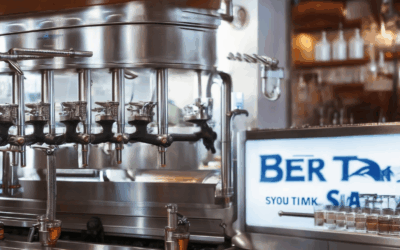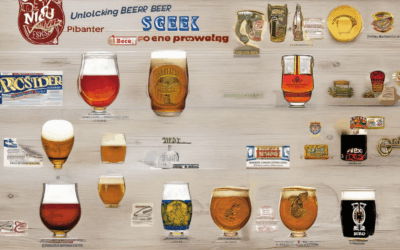Beer has been a cherished part of human culture for thousands of years, evolving from a simple fermented drink to a craft with intricate processes and rich flavors. While many of us enjoy the taste of beer, few delve into the complexities of its production or the theories that shape its creation. From the chemistry of fermentation to the art of blending flavors, beer production is a science that demands precision and understanding. In this article, we will explore the key concepts of beer theory, delving into the principles that guide brewers and enthusiasts alike. Whether you’re curious about the role of malted grains or the impact of yeast strains, this guide will provide insights into the theories that define modern beer production.
Key Takeaways
– Malted Barley drives the brewing process, providing essential starches for sugar conversion and influencing beer flavor profiles.
– Hops add bitterness, aroma, and preservation, varying by beer style from IPAs to wheat beers.
– Yeast is crucial for fermentation, converting sugars into alcohol and shaping flavor notes like fruity or clean finishes.
– Water Quality significantly impacts beer taste, with soft water ideal for lighter beers and hard water enhancing body in stouts and ales.
– Fermentation Temperature Control ensures optimal yeast performance, balancing flavor and alcohol content.
– Brewing Process Steps include mashing, boiling, fermentation, conditioning, and aging to refine flavor and texture.
– Sanitation and Sterility prevent contamination, ensuring a consistent and safe brewing environment.
– Diverse Beer Styles cater to varied tastes, from lagers emphasizing smoothness to stouts featuring roasted malt depth.
– Yeast Strain Diversity contributes unique characteristics, with Belgian yeasts for complex flavors and American yeasts for crispness.
– Aging and Maturation enhance flavor integration and texture, especially in barrel-aged beers.
– Beer production blends art and science, creating nuanced beverages tailored to personal style and tradition.

What Are the Basic Principles of Beer Theory?
The basic principles of beer theory revolve around the essential components and processes involved in brewing. Here’s a breakdown of the core concepts:
Malt
Malt is the foundation of beer, derived from starches in barley. During brewing, starches are converted into sugars, which become the fermentable material for yeast. Malt contributes to the body, sweetness, and overall flavor profile of beer. Different varieties of malt, such as pale ale, wheat, and roasted malt, influence the final product’s characteristics.
Hops
Hops are a key ingredient in beer, contributing bitterness, flavor, and aroma. They are added during the boil to extract bitterness and later during fermentation for aromatic qualities. Hops can range from mild to heavily bitter, depending on the type and amount used. The International Bitterness Units (IBU) scale measures bitterness levels.
Yeast
Yeast is responsible for fermentation, converting sugars into alcohol and carbon dioxide. Different yeast strains yield varying flavor profiles, from fruity and spicy notes in Belgian ales to clean finishes in German lagers. Yeast also influences the beer’s mouthfeel and attenuation (reduction of sweetness).
Fermentation and Aging
After boiling and fermenting, beer undergoes conditioning through cold storage, allowing yeast activity to slow down and flavors to meld. This process enhances clarity and reduces harshness, resulting in a smoother drink.
Flavor Profiles
Beer flavor profiles vary significantly based on style. Common categories include:- Malt-forward : Highlighting caramel, toasty, or nutty notes (e.g., amber ales, brown ales).- Hop-forward : Emphasizing citrus, pine, or resinous flavors (e.g., India Pale Ales, double IPAs).- Sour/Tart : Featuring acidic, tangy, or fruity characteristics (e.g., Berliner Weisse, American Wild Ales).
By understanding these principles, brewers can craft a wide variety of beer styles to suit different tastes and preferences.
Key Chemical Processes in Beer Production
The production of beer involves several critical chemical processes that transform raw ingredients into a refreshing beverage. Here’s a breakdown of the primary steps:
- Starch Conversion :
Malted grains, typically barley, are used to produce sugars through a process called malting. Enzymes released during malting break down starches into fermentable sugars, which yeast later converts into alcohol. - Hop Extraction :
Hops, known for their bitterness and flavor, are added during the brewing process. Their active compounds, such as alpha acids, contribute to the beer’s taste and aroma. Extraction methods ensure these compounds are effectively incorporated into the brew. - Fermentation :
Yeast is the catalyst for fermentation, converting sugars into ethanol and carbon dioxide. This process not only produces alcohol but also creates the fizz associated with beer. - Conditioning :
After fermentation, beer undergoes conditioning, which includes aging and filtration. Cold lagering enhances flavor and clarity, while filtration removes impurities, resulting in a smoother drink. - Final Adjustments :
Towards the end, brewers may add finishing hops for extra flavor and aroma. The final product is then packaged, often pasteurized to ensure freshness and prevent spoilage.
These processes collectively result in a well-balanced beer, rich in flavor and complexity.

Understanding Beer Production
The fundamental concepts of beer production revolve around transforming malted barley and other ingredients into a refreshing beverage through a series of processes. Here’s a breakdown of the key components and steps involved:
- Malt : Malted barley is the core ingredient in beer production. During malting, barley kernels undergo germination and drying, which converts starches into sugars. These sugars become the primary source of fermentable material for yeast.
- Hops : Hops are added during the boiling process to contribute bitterness, flavor, and aroma to the beer. They also act as a preservative. Different hop varieties impart unique characteristics, influencing the final taste profile.
- Water : Water quality is critical as it affects the flavor and mouthfeel of the beer. Brewers often use soft water to enhance the malt flavors, while harder water can provide a smoother finish.
- Yeast : Yeast is the catalyst for fermentation. brewers use proprietary yeast strains to convert sugars into alcohol and carbonation. The type of yeast and fermentation temperature greatly impact the beer’s character.
- Boiling and Fermentation : After mashing (breaking down the malt), the mixture is boiled to preserve hops and simplify the wort. Fermentation occurs in tanks where yeast converts sugars into alcohol and releases CO2, leading to carbonation.
- Aging : Beer ages in storage tanks to allow flavors and aromas to meld. This process enhances complexity and reduces any harshness, resulting in a more balanced beer.
- Packaging : Finally, beer is packaged in bottles, cans, or kegs for distribution. Canning has become popular due to its convenience and extended shelf life compared to bottles.
These steps combine art and science to create a versatile beverage enjoyed worldwide. From the selection of ingredients to the careful monitoring of fermentation, each stage plays a vital role in crafting a quality beer.

Essential Principles of Beer Production
Beer production is governed by several fundamental principles that ensure the creation of a quality product. These principles revolve around the selection of ingredients, controlled fermentation, and precise brewing processes.
- Malted Barley : The backbone of beer production, malted barley provides the necessary starches that convert into sugars during fermentation. Different varieties of barley result in beers with unique flavors, from light lagers to robust stouts.
- Yeast : Yeast plays a crucial role in fermentation, converting sugars into alcohol and carbon dioxide. Brewers often use specific strains of yeast, such as Saccharomyces cerevisiae, to achieve desired flavor profiles and fermentation rates.
- Water Quality : The purity and chemistry of water significantly impact beer taste. Soft water is ideal for lighter beers, while hard water may enhance the body of darker ales and stouts.
- Hops : Hops are added during the brewing process to provide bitterness, flavor, and aroma. Their usage varies by region and beer style, influencing everything from IPAs to wheat beers.
- Fermentation Temperature Control : Maintaining optimal temperatures during fermentation ensures the yeast produces the desired alcohol content and flavor compounds. Too high, and the beer may become harsh; too low, and the fermentation may stall.
- Brewing Process Steps :
- Mashing : Breaking down starches in malted barley to release fermentable sugars.
- Boiling : Extracting hop flavors and aromas while killing off unwanted microorganisms.
- Fermentation : Allowing yeast to multiply and produce alcohol and carbonation.
- Conditioning : Post-fermentation adjustments to fine-tune flavor and mouthfeel.
- Aging and Maturation : In some cases, beer is aged to allow flavors to meld and unwanted components to settle out, enhancing overall quality.
- Sanitation and Sterility : Proper cleaning and sterilization procedures are essential to prevent contamination, ensuring a safe and consistent brewing environment.
By mastering these principles, brewers can craft a wide variety of beers that cater to different tastes and preferences. The careful balance of these elements is what makes beer production both an art and a science.
Key Components of Beer Theories
The production of beer involves several complex scientific principles and processes, often referred to as beer theories. These theories govern the creation of different beer styles, flavors, and aromas, ensuring consistency and uniqueness in each brew. Below are the primary components of beer theories:
- Fermentation Process
- Fermentation is the cornerstone of beer production, where yeast converts sugar into alcohol.
- The type of yeast used significantly impacts the final product, with ale yeasts producing fruity notes and lager yeasts offering cleaner finishes.
- Temperature control during fermentation affects both the rate of fermentation and the resulting flavor profile.
- Malted Barley
- Malted barley is the primary ingredient in most beers, providing the necessary starches that yeast converts into sugars.
- The malting process enhances the sweetness and body of the beer, while also contributing to head retention.
- Different varieties of barley, such as Marzen or Munich, are known for their unique contributions to beer flavor.
- Hops
- Hops act as both a preservative and a flavoring agent in beer.
- Their bitterness, derived from hop acids, balances the sweetness of malted barley.
- Hops also contribute floral and citrusy notes, adding complexity to the beer’s aroma and taste.
- Water Quality
- Water is a critical ingredient in beer, influencing both the flavor and mouthfeel.
- The mineral content of water plays a significant role in determining the beer’s profile, particularly in traditional European beers.
- Soft water is often preferred for lighter beers, while hard water may be better suited for robust styles like stouts or porters.
- Brewing Process
- The brewing process encompasses several steps, including mashing, boiling, fermentation, and conditioning.
- Mashing converts starches into sugars, while boiling extracts flavors and reduces foam.
- Conditioning, often achieved through cold storage, enhances clarity and mouthfeel.
- Yeast Types
- Yeast diversity is crucial, with different strains offering unique characteristics.
- Belgian yeasts are known for their ability to produce complex flavors and high alcohol content.
- American yeasts tend to produce clean, crisp beers with minimal esters.
- Aging and Maturation
- In some cases, beer undergoes extended aging to develop deeper flavors and smoother textures.
- Cellaring allows the beer to settle, reducing carbonation and enhancing integration of flavors.
- This process is particularly important for barrel-aged beers, which develop unique characteristics from wood contact.
- Beer Styles
- Beer theories also account for the diversity of beer styles, each with distinct flavor profiles and production methods.
- Styles like IPAs emphasize hop bitterness and citrus notes, while porters focus on roasted malt and coffee-like flavors.
- Lagers, known for their smoothness and clean finish, are produced using a cool fermentation process.
By understanding these key components, brewers can craft beers that reflect specific flavor preferences and traditions, catering to a wide range of tastes and preferences.

The Main Theories Involved In Beer Production
Beer production involves several key theories and processes that work together to create the perfect brew. Below are the main theories and principles that shape modern brewing:
- Fermentation Theory
- Yeast plays a crucial role in converting sugar into alcohol and carbon dioxide through a process called fermentation.
- Temperature control during fermentation is essential to guide the yeast’s activity, ensuring optimal flavor development.
- Different types of fermations (primary, secondary, and conditioning) contribute to the final character of the beer.
- Brewing Process Theory
- Malted ingredients like barley are the foundation of most beers, providing starches that get converted into sugars during brewing.
- Water treatment is critical, as the quality and mineral content of water significantly influence the taste and mouthfeel of the beer.
- Hops are added during the boil to provide bitterness, aroma, and flavor, while also acting as a preservative.
- Yeast Management Theory
- Understanding yeast strains is vital for consistent and high-quality beer production. Different strains offer unique characteristics like fruity notes or spicy flavors.
- Monitoring pH levels ensures the yeast remains healthy and active throughout the fermentation process.
- Aging or cellaring beer can enhance its complexity, allowing flavors to meld together over time.
- Malt Theory
- Malting processes transform raw grains into usable materials for brewing, impacting both the color and body of the beer.
- Different malted ingredients like wheat, rye, and oats contribute unique textures and flavors to craft beers.
- Roasting malt adds depth and complexity, often used in stouts and porters for rich, full-bodied beers.
- Flavor and Aroma Theory
- Hop utilization varies depending on the style of beer, influencing bitterness, aroma, and finish.
- Esters and phenols produced by yeast can add fruity or spicy notes to the beer’s profile.
- Coffee, chocolate, and other flavor additions are popular in specialty beers, enhancing the drinking experience.
These theories work together to create a complex and nuanced beverage. By mastering each component, brewers can craft beers that reflect their personal style while staying true to traditional methods.
For more details on specific brewing techniques and tools, explore our Brewing Techniques Guide . To learn about the best malted ingredients, visit our Malt Guide .





0 Comments